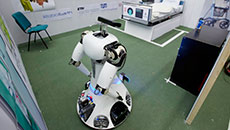Like so many interesting discoveries, this one happened largely by accident. An astronomer has discovered an ‘upside-down planet’ that reveals new method for studying binary star systems.
A binary star system is where two stars are so close that their gravitational interaction causes them to orbit about a common centre of mass.
Working with astronomer Eric Agol, Ethan Kruse, a doctoral student at University of Washington has confirmed the first “self-lensing” binary star system.
“I found what essentially looked like an upside-down planet. What you normally expect is this dip in brightness, but what you see in this system is basically the exact opposite - it looks like an anti-transit,” Kruse explained.
Using the planet-hunting Kepler Space Telescope, Kruse’s discovery confirms an astronomer’s prediction in 1973 - based on stellar evolution models of the time - that such a system should be possible.
The two stars of KOI-3278, about 2,600 light-years (a light-year is 5.88 trillion miles) away in the Lyra constellation, take turns being nearer to earth as they orbit each other every 88.18 days.
They are about 43 million miles apart, roughly the distance the planet Mercury is from the sun.
The white dwarf, a cooling star thought to be in the final stage of life, is about the earth’s size but 200,000 times more massive.
That increase in light, rather than the dip I thought I would see, was the white dwarf bending and magnifying light from its more distant neighbour through gravitational lensing, like a magnifying glass, Kruse noted.
“The basic idea is fairly simple. Gravity warps space and time and as light travels toward us it actually gets bent, changes direction. So, any gravitational object - anything with mass - acts as a magnifying glass, though a weak one,” Agol added.
The cool thing, in this case, is that the lensing effect is so strong, “we are able to use that to measure the mass of the closer, white dwarf star. And instead of getting a dip now you get a brightening through the gravitational magnification”, Kruse said.
Gravitational lensing is a common tool in astronomy.
It has been used to detect planets around distant stars within the Milky Way galaxy, and was among the first methods used to confirm Albert Einstein’s general theory of relativity, said the paper published in the journal Science.





